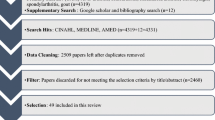Abstract
Complementary and alternative medicine (CAM) has become popular with consumers worldwide and accounts for significant private and public health expenditures. According to earlier reports, the prevalence of CAM use by rheumatoid arthritis (RA) patients in the United States is anywhere between 28% and 90%. Extensive use among RA patients and the limited knowledge among physicians had confirmed the need to evaluate the increasing prevalence of various CAM modalities. The primary aim of this study was to identify the incidence of CAM usage among our RA patients. Additionally, we aimed to correlate patient demographics and disease characteristics with the use of specific CAM modalities. An analysis of data extracted from our institution’s RA longitudinal registry was performed. The patients were asked to select from a list the modalities they were currently using and/or had used in the past. Of patients, 75.9% reported current or past use of CAM with >10% using 12 different modalities. Nutritional supplements and touch therapies were the most widely used overall, with mind–body therapies more prevalent among younger patients. CAM users were found to have more extra-articular manifestations and fewer comorbidities than non-CAM users. The use of CAM among RA patients is widespread with a broad spectrum of CAM modalities being used in early stages of the disease, frequently in conjunction with mainstream conventional treatments. Therefore, CAM may no longer be considered the rheumatoid patients’ last resort.
Similar content being viewed by others
References
Ramos-emus C, Gamez-Nava JI, Gonzalez-Lopez L, Skeith KJ, Perla-Navarro AV, Galvan-Villegas F (1998) Use of alternative therapies by patients with rheumatic disease in Guadalajara, Mexico: prevalence, beliefs, and expectations. Arthritis Care Res. 11 no. 5, 411–418
Barnes PM, Powell-Griner E, McFann K, Nahin RL (2004) Complementary and alternative medicine use among adults: United States, 2002. Adv. Data 343:1–19
Brune K (2004) Safety of anti-inflammatory treatment—new ways of thinking. Rheumatology (Oxford) 43 no. Suppl 1, i16–i20
Soeken KL, Miller SA, Ernst E (2003) Herbal medicines for the treatment of rheumatoid arthritis: a systematic review. Rheumatology (Oxford) 42 no. 5, 652–659
Astin JA (1999) Use of alternative medicine by women with breast cancer. N. Engl. J. Med. 341 no. 15, author reply 1156–7
Zanette Sde A, Born IG, Brenol JC, Xavier RM (2008) A pilot study of acupuncture as adjunctive treatment of rheumatoid arthritis. Clin. Rheumatol. 27 no. 5, 627–635
Cheung CK, Wyman JF, Halcon LL (2007) Use of complementary and alternative therapies in community-dwelling older adults. J. Altern. Complement Med. 13 no. 9, 997–1006
Saydah SH, Eberhardt MS (2006) Use of complementary and alternative medicine among adults with chronic diseases: United States 2002. J. Altern. Complement Med. 12 no. 8, 805–812
Taibi DM, Bourguignon C (2003) The role of complementary and alternative therapies in managing rheumatoid arthritis. Fam. Community Health 26 no. 1, 41–52
Sutherland LR, Verhoef MJ (1994) Why do patients seek a second opinion or alternative medicine?. J. Clin. Gastroenterol. 19 no. 3, 194–197
Marquis MS, Davies AR, Ware JE, Jr (1983) Patient satisfaction and change in medical care provider: a longitudinal study. Med. Care 21 no. 8, 821–829
Bensoussan A (1999) Complementary medicine—where lies its appeal?. Med. J. Aust. 170 no. 6, 247–248
Astin JA (1998) Why patients use alternative medicine: results of a national study. JAMA 279 no. 19, 1548–1553
Yim YK, Lee H, Hong KE, Kim YI, Lee BR, Son CG (2007) Electro-acupuncture at acupoint ST36 reduces inflammation and regulates immune activity in collagen-induced arthritic mice. Evid. Based Complement Alternat. Med. 4 no. 1, 51–57
Selvam R, Ganesan K, Narayana Raju KV, Gangadharan AC, Manohar BM, Puvanakrishnan R (2007) Low frequency and low intensity pulsed electromagnetic field exerts its anti-inflammatory effect through restoration of plasma membrane calcium ATPase activity. Life Sci. 80 no. 26, 2403–2410
Author information
Authors and Affiliations
Corresponding author
Additional information
Level IV: Retrospective Case Series
Each author certifies that he or she has no commercial associations (e.g., consultancies, stock ownership, equity interest, patent/licensing arrangements, etc.) that might pose a conflict of interest in connection with the submitted article.
Each author certifies that his or her institution has approved the reporting of these cases, that all investigations were conducted in conformity with ethical principles of research.
Rights and permissions
About this article
Cite this article
Efthimiou, P., Kukar, M. & MacKenzie, C.R. Complementary and Alternative Medicine in Rheumatoid Arthritis: No Longer the Last Resort!. HSS Jrnl 6, 108–111 (2010). https://doi.org/10.1007/s11420-009-9133-8
Received:
Accepted:
Published:
Issue Date:
DOI: https://doi.org/10.1007/s11420-009-9133-8




